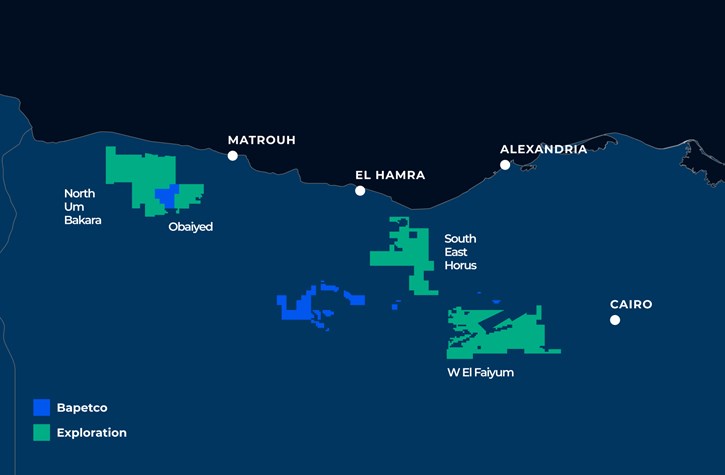

In September 2021, the company together with consortium partner Cheiron, acquired a portfolio of upstream oil and gas production, development and exploration interests in the Western Desert, onshore Egypt.
Production
The producing assets are located across four concession areas:
- Obaiyed (Capricorn 50% WI) contains Egypt’s largest onshore gas field
- Badr El Din (BED) (Capricorn 50% WI) comprises five producing concessions, both oil and gas
- North East Abu Gharadig (NEAG) (Capricorn 26% WI) comprises the concession covering the NEAG Tiba area and the NEAG Extension area
- Alam El Shawish West (AESW) concession area (Capricorn 20% WI)
Development activity in these concessions is guided by a broad portfolio of new well candidates and projects. Following a hiatus in drilling during the first half of 2024, activity recommenced in mid-year with three rigs allocated across the Bapetco concession areas. The focus of development activity is focused on the Abu Roash reservoir targets within the BED concession, where step-out and delineation wells continue to extend the field limits and add reserves. Much of the new well activity has been focused on this liquids-rich area which benefits from stacked reservoir targets. Within BED the consortium has been actively developing an inventory of additional opportunities to ensure continuity of development activity in this area.
The consortium continues to assess facilities projects to manage asset integrity and add production where possible. In 2023 facilities projects were completed at BED, Teen and Karam. These projects focused on optimising gas production with compression and low-pressure production optimisation, further opportunities for such projects will continue to be evaluated by the consortium.
Decarbonisation initiatives are in place to reduce flaring, venting and fugitive emissions in line with Capricorn’s net zero commitments. Capricorn’s operated data (direct from our contractors) is recorded in our GHG inventory where emission factors are applied – we receive annual support and limited assurance on this data set, enabling the continuous improvement of our reporting disclosures. Our non-operated data is received directly from our partners with emission factors already applied, and independent verification of this calculation methodology for GHG emissions, associated with our 2022 baseline was completed in Q4 2022. Our operated and non-operated data set directly contributes to this baseline which underpins our equity Scope 1 and Scope 2 emission reduction targets of 15% by 2023, 30% by 2030, with a commitment to achieve net zero by 2040.
Exploration
Capricorn has a non-operated participation in three exploration concessions in the Western Desert, held in 50:50 joint ventures with Cheiron. As a consequence, Capricorn is exposed to a variety of opportunity types from unconventional resource opportunities, established proven play types and near field opportunities.
With the resumption of drilling activity in mid-2024 exploration drilling will be located on two of the exploration concessions in the Western Desert. These concessions present the opportunity to target conventional and unconventional objectives with a total of four wells planned. Additionally, further exploration drilling will be scheduled in 2025 in the acreage near the Obaiyed field.
On the Bapetco concessions the consortium continues to mature near-field exploration targets. These opportunities have been an area of success since entry into the assets and in particular in the BED area where new hydrocarbon pools, such as at BED15 have been discovered and subsequently developed.
